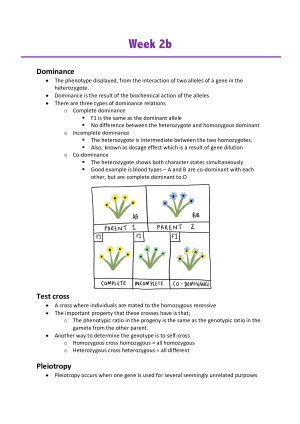H1 (94) Plant Breeding and Genetics AGRI30048 Clear and Concise notes
Subject notes for UniMelb AGRI30048
Description
These notes include hand-drawn images and information about the following content; Transcription and Translation Domestication Domestication: What traits changed? Bottleneck effect Domestication syndrome Landrace Genebanks Main factors that affect flowering Flowering Locus C (FLC) gene Transcription regulators Flowering types Photoperiodism Circadian gene behaviour Double fertilisation Plant reproductive system Outbreeding types Mechanisms to promote self-pollination Mechanisms to prevent self-fertilisation Dominance Test cross Pleiotropy Epistasis – gene interaction Independent assortment Genetic linkage Detection of linkage Recombination/meiosis – process Coupling vs Repulsion (phases) Types of linkage Genetic distance Case study – Barley Brittle rachis Quantitative vs Qualitative traits Multigene/Polygenetic inheritance Genetic Model Heritability Quantitative trait example Response to selection – quantitative traits Heterosis Types of segregation Genetic basis of heterosis What is unique about hybrids? Molecular marker Traditional plant breeding Limitations of traditional techniques DNA-assisted breeding Advantages of molecular markers Polymorphic markers DNA molecular markers – techniques Key elements of molecular biology Detection of sequence polymorphism PCR – polymerase chain reaction – process Genetic marker and linkage How to make genetic linkage maps Quantitative trait loci (QTL) mapping Association mapping Bi-parental mapping vs. Association mapping strengths Why is the genomic sequence useful? History of gene sequencing How does Gene sequencing work? Genome annotation Types of mutation in genes How do we look for SNPS? SNP in relation to gene position SNPs as genetic markers Marker assisted selection Synteny, Collinear, Ortholog, Paralog How to identify syntenic regions Why is synteny useful? Gene sequence alignment Pairwise vs multiple alignment Building phylogenetic trees Methods of building phylogenetic trees Phylogenetic tree anatomy What is plant breeding? Making progress in plant breeding program Breeding program design factors Priority traits Conventional breeding process – artificial crossing and selection Product of self-pollinated breeding programs Common breeding methods for self-pollinated species Pedigree method Bulk population method Single seed descent Backcross method Tools to speed up the breeding cycle Doubled haploids Cross-pollination (outbreeding) mechanisms Outbreeding types Self-incompatibility Genetic structure of cross pollinated populations Inbreeding depression Breeding methods Mass selection Recurrent selection Hybrids How do we make an F1 hybrid? Comparison of methods What are hybrids? Hybrid varieties Hybrid varieties in the cropping industry Hybrid varieties – issues Requirements to produce hybrids Methods of commercial production of hybrids Mechanical Male sterility Cytoplasmic male sterility and fertility restoration Quality control in hybrid production Self-incompatibility for hybrid production Combining ability Hybrid breeding and the seed industry Types of crop plant stressors Tolerance through genetic inheritance Gene types for stress tolerance Rust disease Plant Breeders Rights What can be registered? Information required for registration application Seed production What makes good sowing seed quality? Farmer saved seeds Status of GM crops in Australia Trade issues – GM crops Regulation of breeding techniques – Genetically modified vs. genome editing Transgenic breeding Importance of transgenic plants Vectors Transformation vectors features Plant tissue culture In Vitro Culture Culture initiation Callus culture Development of the transgenic plant Agrobacterium tumefaciens Identifying elite transgenic events Crossing transgenic events into elite backgrounds What is genome editing? DNA repair mechanisms-based genome editing Genome editing technologies Discovery of CRISPR-Cas complex in E. coli Hijacking of CRISPR for genome editing Application for precision plant breeding Regulation of CRISPR and GMO USA Corn yield improvements USA wheat production Control of cereal cyst nematode in Australia Barley success story – Australia Main interests of crop remote sensing What is remote sensing? Spectral signatures Indicators of crop status from remote sensing Speed breeding Sensing of light by plants Circadian clocks Biological oscillator Transcriptional feedback loops Sensing of light by plants and circadian clocks – summary Speed breeding in the context of plant breeding Genome Polyploidy Polyploidy in plants vs animals Polyploidy vs Aneuploidy How can polyploidy occur? Terminology Types of polyploidy Advantages of polyploidy
UniMelb
Semester 2, 2020
71 pages
15,615 words
$39.00
14
Campus
UniMelb, Parkville
Member since
February 2018
- Fundamentals of Chemistry CHEM10007 Detailed H1 Notes
- Companion Animal Biology - Detailed H1 notes
- H1 (87) Ecology and Grazing Management AGRI20036 Clear and Concise notes
- H1 (85) Principles of soil science AGRI20038 Clear and Concise notes
- H1 (88) Food for a healthy plant 2 (UNIB20014) notes
